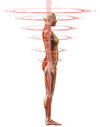The Chakras
A Contemporary Clinical View
Ancient Origins and Subtle Systems
The concept of chakras stems from Eastern traditions — Hindu, Taoist, Sufi, and other philosophical systems — where they have long been understood as subtle centres of force. These traditions, predating modern neurology, described a sophisticated anatomy of the inner body. In recent decades, the chakra model has been integrated into eclectic Western spirituality as a way to explore the interface between soma, psyche, and energy.
Clinical Observation through Mudras
Over forty years of clinical work using hand mudras to ‘read’ the chakras suggests that they operate not as metaphysical organs, but as capacitors within the autonomic and hormonal systems. These energy centres influence the vegetal self— the autonomic, homeostatic substrate of the body. Each chakra appears to act via sympathetic plexi and associated neuronal structures, affecting not only physiological but also emotional and sensory states.
Chakras manifest subtle circular motion — echoing archetypal symbols like the ouroboros — generating perceptible fields through movement, sensation, and electromagnetic activity. These can be perceived by practitioners who cultivate refined sensory or intuitive awareness.
Siddhis and Perception
The siddhis — often described as psychic or intuitive gifts — are not necessarily spiritual achievements. Rather, they are latent human faculties for perceiving subtle signals within oneself and others. Such perception may arise kinesthetically, visually, or through transference, where the practitioner’s body reflects the state of the client.
In some traditions, siddhis are seen as obstacles to deeper spiritual growth, vanishing as inner work deepens. Yet in the clinical or diagnostic domain, they can offer access to otherwise inaccessible layers of the client’s field.
Anatomy of the Chakras: Anterior and Posterior Perspectives

Anterior Chakras and Sympathetic Plexi
- Coccygeal – Inferior hypogastric (pelvic) plexus
- Sacral – Presacral and related pelvic plexi
- Solar Plexus – Coeliac, mesenteric, and abdominal aortic plexi
- Heart – Coronary plexuses
- Throat – Superior, middle, cervicothoracic (stellate) ganglia
- Brow – Pituitary and pineal axes
- Crown – Corpus callosum and associated fields
Posterior Chakras and Held Feelings
- Coccygeal – Holding the past
- Sacral – Potential and possibility
- Solar – Resistance to change
- Heart – Barriers to emotional love
- Throat – Inhibited expression
- Brow – Obstructed vision and strategy
- Crown – Distorted clarity of thought
Posterior chakras correlate with functional elements of the sympathetic trunk, especially cervicothoracic and lumbosacral ganglia.
NB: The brow and crown chakras may not be directly innervated by sympathetic traffic but may reflect fields generated by the motility of cranial structures and the ventricular system.
The Autonomic Nervous System and the Energetic Field
The sympathetic system constantly monitors and regulates internal states — balancing survival functions, visceral tone, and emotional responses. The parasympathetic-vagal system also feeds back data to the brain, especially the gut–brain axis, reinforcing the importance of sensation in shaping cognition and affect.
Osteopathic models highlight the ANS as central to both dysfunction and healing. Repeated afferent signals from distorted structures create a “facilitated segment” in the spinal cord, leading to altered motor and vascular responses. This feedback loop shapes how we move, feel, and act — a process rooted in the maxim: structure governs function.
The Cranial Fluid Dynamics model extends this view, incorporating the influence of subtle, exogenous forces that affect our body and perception. Skin and sensory fields detect more than mechanical touch; they register subtle field interactions that are processed unconsciously but impact blood flow, lymphatics, hormonal rhythms, and emotional states.
Chakras as Containers of Sensation
Chakras may function as containers — storing, holding, and recycling vegetal signals, whether from poor health, food, trauma, or inherited patterns. When these centres are cleared, the body’s vegetal intelligence can nourish the animal self more coherently. This brings the instinctual self back into alignment, so it can serve the human self with clarity and congruence.
On the 14th Chakra and the Djinn
The 14th chakra — the deep interior of the base — is likened to Aladdin’s cave. Entering this space symbolises a return through ancestral memory to recover one’s own inner vessel or lamp. As the lamp is polished, the djinn (from Arabic jannu, root of gene/genome/genie) is released — a metaphor for activating dormant genetic or spiritual potential.
Clearing the Field
When chakras are freed from retained sensation or story, the inner field quietens. This shifts the body’s homeostasis, easing the autonomic load and allowing the vegetal rhythm to reassert a harmonious state.
This understanding positions the chakras not as esoteric concepts but as physiological–energetic systems that mediate between tissue, emotion, and meaning. Their function is less about transcendence and more about clearing the inner terrain, so deeper integration and development — including spiritual growth — can occur.
Further reading:
Read: Chakras article 2